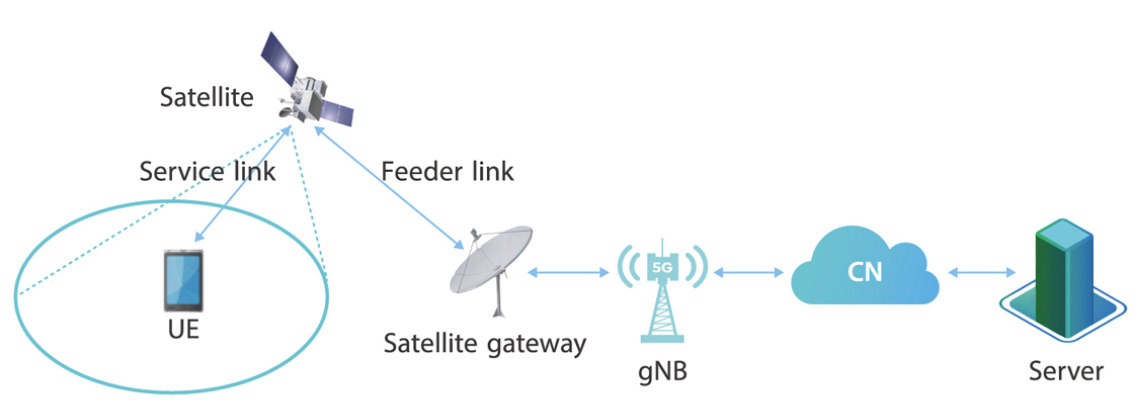From the perspective of global network coverage, more than 80% of land areas and 95% of sea areas are not covered by ground cellular networks. The 5G network was built not only to provide high network speeds, but also ubiquitous mobile network access. However, in remote areas such as mountainous areas, deserts, and the ocean, building and maintaining a 5G terrestrial network is extremely expensive, which makes it impossible to provide 5G network coverage in those areas.
Fortunately, the development of aerospace technology enables the satellite-based broadband communication system to provide radio coverage to large or even global areas at a much lower cost. As such, the 5G network will deeply integrate with the satellite communication system to constitute a convergent communication network that provides seamless coverage on the planet, meeting various service requirements anywhere in the world.
What is a Non-terrestrial network (NTN)?
Non-terrestrial Network (NTN) is a terminal-satellite direct communication technology based on the new radio (NR) interface technology developed by 3GPP in R17 and is also an important supplement to terrestrial cellular communication technology. With the integration of the satellite communication network and the ground 5G network, NTN can provide ubiquitous coverage without being restricted by terrain and landform, and connect the sky, earth, sea, and other spaces to form an integrated ubiquitous access network that enables on-demand access in all scenarios.
NTN is an important function of 3GPP R17. It continues to evolve in the 5G-Advanced stage and has become an important part of the 3GPP R18 work plan. NTN includes two workgroups: IoT NTN and NR NTN. IoT NTN focuses on satellite IoT services that support low-complexity eMTC and NB-IoT terminals, such as global asset tracking (sea containers or other terminals beyond the coverage of cellular networks). NR NTN uses the 5G NR framework to enable direct connection between satellites and smartphones to provide voice and data services.
Transparent NTN architecture
NTN consists of the user equipment (UE), satellite, satellite gateway, base station (gNB), core network (CN), and server. Its architecture will evolve from a more feasible transparent payload.

NTN can be a constellation of LEO, MEO, or GEO satellites, or a network of HAPS (High Altitude Platform Stations). The NTN node (LEO, MEO, GEO, HAPS) acts as a repeater, performing frequency conversion and power amplification, and is transparent to the UE. The eNB/ gNB is located on the ground and connected to the NTN node via an NTN gateway.

This NTN feature is only available in FDD operation due to the round-trip delay of the signal via satellite. In Rel-17, NTN is applicable in FR1 using S-band or L-band. Handheld devices, IoT devices, or VSAT terminals (with directive antenna and higher transmit power) can be the UE connecting to NTN. An NTN-capable UE must compensate for the time and frequency offsets caused by propagation delay and satellite motion in the uplink transmission. GNSS positioning capability is required for the UE to calculate the time and frequency compensations together with the satellite position and velocity in the system information broadcast.
Advantages of 5G NTNs
- It offers much wider coverage than traditional terrestrial networks. Since the NTN network operates from a high altitude, it can cover a vast area without the need for large numbers of ground-based infrastructure. This makes 5G NTN networks a reliable way to provide connectivity to remote and rural areas, where traditional infrastructure is not practical.
- Ideally, with speeds of up to 20 Gbps, 5G NTN networks can handle large amounts of data quickly and efficiently. This makes them ideal for applications that require real-time data processing, such as remote monitoring, surveillance, and autonomous vehicles.
Disadvantages of 5G NTNs
Despite its many advantages, there are also some challenges associated with 5G NTN technology:
- One of the main obstacles is the cost of deployment. Building and launching satellites and other airborne vehicles is a costly undertaking, and it may take some time for these costs to be recouped through revenue generated by the network.
- Another disadvantage of 5G NTN technology is its unreliability compared to traditional terrestrial networks. Since the network operates wirelessly from a high altitude, it is susceptible to interference from terrain, weather, and other factors that can disrupt wireless networks. This means that 5G NTN networks may be unable to provide connectivity in harsh environments. Another factor that can impact 5G NTN performance is atmospheric attenuation. This occurs when the signal passes through the atmosphere, which can cause the signal to weaken or become distorted. This can happen due to a variety of atmospheric factors, including humidity, temperature, and pressure.
- The potential for cyberattacks and other security breaches as the network operates from a high altitude, it is difficult to monitor and secure.
What is the Next?
Rel-18 enhancements in NR to support NTN connectivity have been decided in these areas:
- Extend NR (FDD mode) NTN to >10 GHz frequency bands, e.g., Ka-band, for VSAT devices. A VSAT terminal has a higher antenna gain and transmit power and can be installed on airborne, maritime, or land-based vehicles for broadband data services. These frequency bands will not be accessible for handheld UE and IoT devices because of the large path loss at high frequencies.
- Coverage enhancement for low-data rate and VoIP services via commercial smartphone in NTN scenarios. VoIP is only applicable for LEO due to the latency associated with propagation distance, while low-data rate service can be provided by all satellites (LEO, MEO, GEO) by sufficient repetitions of transmission.
- Improve UE mobility in NTN earth-fixed and earthmoving cells, as well as mobility between NTN and TN, for service continuity through enhanced procedures of measurements, cell re-selection, and handover. Tracking areas will be earth-fixed as in Rel-17.
- Network verification of UE location report to meet regulatory requirements in terms of accuracy, latency, reliability, etc. for various purposes (e.g., emergency call, lawful intercept, public warning, charging/billing).
References:
- 3GPP/5G Non-Terrestrial Networks.
- ZTE.
- 5G Americas.
- Everythingrf.
